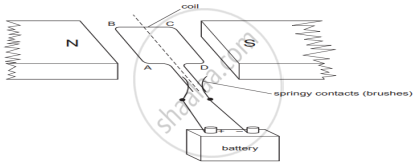Advertisements
Advertisements
प्रश्न
उत्तर
(i) Fleming's left hand rule is used to find out the direction of Lorentz force on a conductor. (ii) Fleming's right hand rule is used to find out the direction of induced current in a conductor.
APPEARS IN
संबंधित प्रश्न
Observe the following figure:

If the current in the coil A is changed, will some current be induced in the coil B? Explain.
State whether the following statement is true or false:
The magnetic field inside a long circular coil carrying current well be parallel straight lines.
What is the shape of a current-carrying conductor whose magnetic field pattern resembles that of a bar magnet?
What type of core should be put inside a current-carrying solenoid to make an electromagnet?
The force experienced by a current-carrying conductor placed in a magnetic field is the largest when the angle between the conductor and the magnetic field is:
45°
60°
90°
180°
Name and state the rule of determine the direction of force experienced by a current carrying straight conductor placed in a uniform magnetic field which is perpendicular to it.
State under what conditions force acting on a current carrying conductor which is freely suspended in a magnetic field can be Zero.
Describe the activity that shows that a current-carrying conductor experiences a force perpendicular to its length and the external magnetic field. How does Fleming’s left-hand rule help us to find the direction of the force acting on the current carrying conductor?
A simple motor is made in a school laboratory. A coil of wire is mounted on an axle between the poles of a horseshoe magnet, as illustrated.

In the example above, coil ABCD is horizontal and the battery is connected as shown.
- For this position, state the direction of the force on the arm AB.
- Why does the current in the arm BC not contribute to the turning force on the coil?
If the strength of the current flowing through a wire is increased, the strength of the magnetic field produced by it ______.
